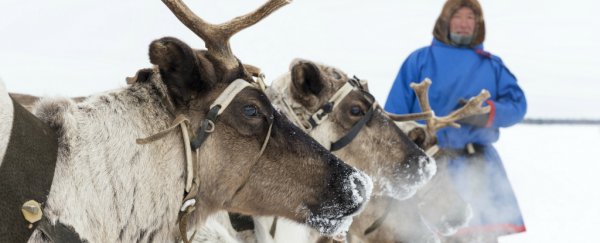Unusual weather patterns in Arctic Russia have caused more than 80,000 reindeer to starve to death over the past 10 years.
And that die-off hasn't been gradual - 20,000 deer have been killed in 2006, and 61,000 animals have starved to death in 2013. That's 22 percent of the entire reindeer population in the affected Yamal peninsula.
And now a new study has shown that both of those years had one thing in common - they experienced the same strange weather pattern at the start of November.
Researchers are now concerned that the same thing might be about to happen again this year.
The problem in both 2006 and 2013 was that unseasonably warm temperatures in early November led to heavy rains, which turned the soft snow that usually covers the Russian tundra into hard ice, cutting off the reindeer's food supply of lichen and other vegetation.
"Reindeer are used to sporadic ice cover, and adult males can normally smash through ice around 2 centimetres thick," lead researcher Bruce Forbes, from the University of Lapland in Rovaniemi, Finland, told Andy Coghlan over at New Scientist.
"But in 2006 and 2013, the ice was several tens of centimetres thick."
Reindeer are an important part of the economy in the Yamal peninsula, and Forbes and his team set out to investigate which combination of weather events had caused the die-off.
After looking at sea ice and weather records, they found that it all came down to ice coverage in the Barents and Kara seas near the Yamal peninsula (the area circled in red below) in early November.
 Google Maps
Google Maps
In both 2006 and 2013, the ice in these regions began to retreat at the start of November - a time when it would usually be building up after the summer thaw.
That lack of sea ice cover increased evaporation and humidity, and combined with unseasonably warm air temperatures, that cocktail resulted in rain clouds, which travelled over the southernmost tip of the Yamal peninsula and dumped 24 hours of torrential rain on reindeer herds being moved south for the winter.
That wasn't so bad, but when temperatures plunged to –40 degrees Celsius (–40 degrees Fahrenheit) for the rest of winter, all that wet ground froze up, leaving a layer of impenetrable ice that lasted for months, and prevented the reindeer from accessing the vegetation below.
In 2006, there were a few gaps in this ice, and 20,000 reindeer starved to death.
But in 2013, 61,000 of the 275,000 reindeer on the peninsula died. "Losing 22 percent of the population has never happened before," Forbes told Coghlan.
The team has now seen worrying signs that this same pattern might be about to happen again.
This September had the second-lowest amount of sea ice cover ever recorded in the Arctic, suggesting that temperatures were far warmer than they usually are at this time of year.
"If we see such events again this year, it could mean that they're becoming more frequent," said Forbes. "Now is the risk window, and if it happens again, it will be a major problem for traditional reindeer herders still suffering from losses in 2013."
Having the same ice coverage this year will be an even more severe blow, because a cull of 250,000 reindeers is already scheduled for the northern Russia tundra, following claims that herds are overgrazing.
An anthrax outbreak has also been linked to the animals. In August this year, at least one child died, and 90 people were hospitalised after anthrax spread from the thawing out of infected reindeer corpses on the Yamal peninsula.
Researchers are also worried about what this thick layer of ice could mean for other plants and animals in the region - especially as our planet becomes hotter and hotter.
"This study serves to underline the fragility of Arctic ecosystems, and how sensitive Earth's climate can be to changes in ice cover," Ed Blockley, lead scientist of the Polar Climate Group at the UK Met Office Hadley Centre, who wasn't involved in the study, told New Scientist.
Hopefully with further monitoring, researchers will be able to better predict when this strange ice coverage is going to happen, and how to protect wildlife when it does.
The research has been published in Biology Letters.
